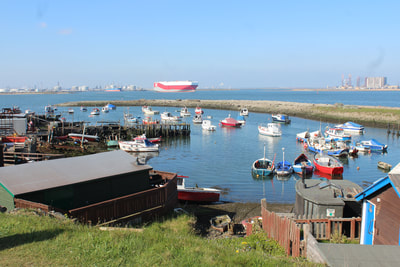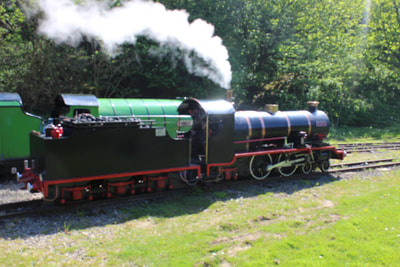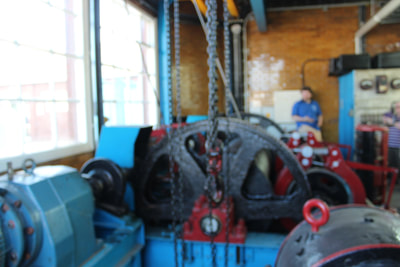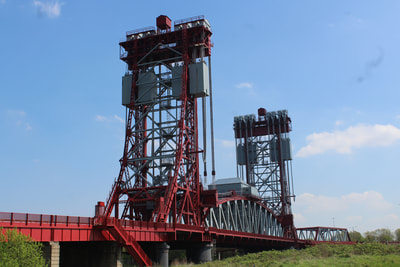LONG WEEKEND 4-7 MAY 2018
NORTH EAST ENGLAND
FRIDAY 4th MAY - KILLHOPE LEAD MINE & MIDDLESBOROUGH TRANSPORTER BRIDGE
We departed from Lime Street Station at 09:06, with 14 people in the minibus and 9 in cars. Many of us convened at Tebay for a brief rest and some refreshments. Afterwards, we headed to Killhope, and due to a detour at Alston, we arrived six minutes behind schedule. Although lunch was enjoyable, it was rather lengthy, which resulted in a delayed start to our tour.
Our guide, Alex was excellent both knowledgeable and enthusiastic and, as is the case with our group, there were lots of good questions. Although at one time the most productive mine in England Killhope did not have a very long life. It started in 1853 using what is known as the Horse Level and closed in 1910. It reopened briefly during World War I then shut for good. The production in the 1870s was so great that the Park Level Mill was built along with the water wheel which is one of only two remaining that were built by William Armstrong of Cragside. Restoration started in 1966 and is ongoing.
Mineshop. This was the first building to be restored and today houses various displays. Washing floor. Here we saw the settling tanks and also the Brunton Buddles. Park Level Mill. The original machinery has all gone but the building has been filled with replica machinery. After a very enjoyable time we set off rather late for the Middlesborough Transporter Bridge.
This is the longest working Transporter Bridge in the world with a span of 851 feet. It took 18 months to build and was designed by the Cleveland Bridge and Engineering Company. William Arrol and company were the builders. It was opened in 1911 by Prince Arthur of Connaught. It suffered bomb damage in World War II but this was repaired and it also survived closure attempts. There were repairs and improvement in 2000 and a glass lift was constructed (sadly I believe it is under repair although you can still walk up!!). A new visitor centre was opened in 2000 by Fred Dibnah (a large difference from Prince Arthur but possibly more appropriate). The main span is 160 feet above the Tees and the Gondola is supported by 30 cables and runs on 60 wheels. We had good traffic conditions and caught up a lot of time en route. We wanted to use the bridge as, when we visit the centre on Sunday the bridge will not be running. We crossed on the gondola and have now done both working bridges in England and Wales.
We then moved on to our hotel, the Claxton in Redcar where we had a very good meal followed by a talk on the Industrial Development of the River Tees by Alan Betteney, secretary of the Cleveland Industrial Heritage Society. This finished a full first day.
NORTH EAST ENGLAND
FRIDAY 4th MAY - KILLHOPE LEAD MINE & MIDDLESBOROUGH TRANSPORTER BRIDGE
We departed from Lime Street Station at 09:06, with 14 people in the minibus and 9 in cars. Many of us convened at Tebay for a brief rest and some refreshments. Afterwards, we headed to Killhope, and due to a detour at Alston, we arrived six minutes behind schedule. Although lunch was enjoyable, it was rather lengthy, which resulted in a delayed start to our tour.
Our guide, Alex was excellent both knowledgeable and enthusiastic and, as is the case with our group, there were lots of good questions. Although at one time the most productive mine in England Killhope did not have a very long life. It started in 1853 using what is known as the Horse Level and closed in 1910. It reopened briefly during World War I then shut for good. The production in the 1870s was so great that the Park Level Mill was built along with the water wheel which is one of only two remaining that were built by William Armstrong of Cragside. Restoration started in 1966 and is ongoing.
Mineshop. This was the first building to be restored and today houses various displays. Washing floor. Here we saw the settling tanks and also the Brunton Buddles. Park Level Mill. The original machinery has all gone but the building has been filled with replica machinery. After a very enjoyable time we set off rather late for the Middlesborough Transporter Bridge.
This is the longest working Transporter Bridge in the world with a span of 851 feet. It took 18 months to build and was designed by the Cleveland Bridge and Engineering Company. William Arrol and company were the builders. It was opened in 1911 by Prince Arthur of Connaught. It suffered bomb damage in World War II but this was repaired and it also survived closure attempts. There were repairs and improvement in 2000 and a glass lift was constructed (sadly I believe it is under repair although you can still walk up!!). A new visitor centre was opened in 2000 by Fred Dibnah (a large difference from Prince Arthur but possibly more appropriate). The main span is 160 feet above the Tees and the Gondola is supported by 30 cables and runs on 60 wheels. We had good traffic conditions and caught up a lot of time en route. We wanted to use the bridge as, when we visit the centre on Sunday the bridge will not be running. We crossed on the gondola and have now done both working bridges in England and Wales.
We then moved on to our hotel, the Claxton in Redcar where we had a very good meal followed by a talk on the Industrial Development of the River Tees by Alan Betteney, secretary of the Cleveland Industrial Heritage Society. This finished a full first day.
Hover over images for captions.
SATURDAY 5th MAY - SOUTH GARE, REDCAR, SALTBURN and SKINNINGROVE
We left the hotel just after 0900 and drove out to the South Gare. This is reclaimed land with construction starting in 1859 and lasting over 20 years. Over 5mn tons of blast furnace slag and 18000 tons of cement were used in the construction as well as a considerable amount of dredged infill. A lighthouse was constructed in 1884 and is run by PD Ports. There was a lifeboat station here for many years but that has now closed. There was also a railway used for the construction and for some time after a wind driven trolley was used for transport.
There are also many defensive remains and the station gained infamy by identifying the German fleet as British prior to the bombardment of the NE coast. The small inlet is known as Paddy’s Hole after the many Irish labourers who worked on the construction. We had three photo stops at the end for general photos, Paddy’s Hole for photos of the fishing huts and boats (and a passing vehicle carrier which had brought new locomotives for Newton Aycliffe) and at a spot to photograph the redundant steelworks. These were opened in 1917 by Dorman Long and nationalised in 1967. Denationalisation occurred 21 years later and the then British Steel merged with Hoogevans in 1999 as Corus Group. This in turn was taken over by Tata Steel and closed in 2009 with the loss of 1700 jobs. It was reopened in 2012 by the Thai firm Sahaviriya Steel Industries but mothballed in 2015 with the company going in to liquidation. There is only the Lakenby section and the bulk handling terminal still open.
We then drove in to Redcar to view both the Zetland Museum where the 1802 boat is kept and also the current RNLI boathouse. We split in to two doing half each then changing. The current lifeboats are an Atlantic 85 on station since March 2012 and named Leicester Challenge 3 B858. Also since September 2015 D796 Eileen May Loach Thomas an ILB has also been on station. In the old Gardiners lifeboat house is the world’s oldest lifeboat Zetland . This was built for the Tees Bay Lifeboat Society in 1802 by Henry Greathead. She joined the RNLI in 1858 and was last used in the great storm of 1880 when, with two lifeboats disabled and the rocket crew out of rockets she was pressed in to service and saved the crew of 7 of the German brig Luna. In 1907 she was moved to her present location where she has remained apart from one trip to Edinburgh in 1963 for a display.
We had a good 90 minutes there before heading for Saltburn where we visited the miniature railway shed and workshops before getting a private run up and down the line. This was opened in 1947 by Mr H Dunn of Bishop Auckland and was 300 yards long. It was extended in 1948 and in 1949 bought a “Blacolveley” 4-4-4T from Basset Lowke. The 60s and 70s were a torrid time for the line and by the end it was largely derelict. In 1983 the Saltburn Miniature Railway Association was formed and by 1985 the railway was up and running again. It is now about 1Km long and has 4 resident engines three diesel and one steam. We were pulled by Saltburn (diesel) and Blacklock R (Steam).
We had lunch folowing the railway visit before moving on to Skinningrove where we visited the Cleveland Ironstone Museum. The museum was founded in 1983 by a group of volunteers on the site of the first Ironstone mine in Cleveland. They were concerned that the many artefacts and records of the industry were being lost and set up the museum to save them.
In 2008/9 a major refurbishment saw the addition of a shop, small cinema and meeting rooms. This had suffered quite extensive damage from the Beast from the East but they laid on a walk down to the harbour with a local historian. We then took the minibus back to the museum where we were treated to tea etc and biscuits and many books were bought. Then it was back to the Claxton in readiness for buffet dinner and a talk by Charles Morris on “Bridges of the Tees”
We left the hotel just after 0900 and drove out to the South Gare. This is reclaimed land with construction starting in 1859 and lasting over 20 years. Over 5mn tons of blast furnace slag and 18000 tons of cement were used in the construction as well as a considerable amount of dredged infill. A lighthouse was constructed in 1884 and is run by PD Ports. There was a lifeboat station here for many years but that has now closed. There was also a railway used for the construction and for some time after a wind driven trolley was used for transport.
There are also many defensive remains and the station gained infamy by identifying the German fleet as British prior to the bombardment of the NE coast. The small inlet is known as Paddy’s Hole after the many Irish labourers who worked on the construction. We had three photo stops at the end for general photos, Paddy’s Hole for photos of the fishing huts and boats (and a passing vehicle carrier which had brought new locomotives for Newton Aycliffe) and at a spot to photograph the redundant steelworks. These were opened in 1917 by Dorman Long and nationalised in 1967. Denationalisation occurred 21 years later and the then British Steel merged with Hoogevans in 1999 as Corus Group. This in turn was taken over by Tata Steel and closed in 2009 with the loss of 1700 jobs. It was reopened in 2012 by the Thai firm Sahaviriya Steel Industries but mothballed in 2015 with the company going in to liquidation. There is only the Lakenby section and the bulk handling terminal still open.
We then drove in to Redcar to view both the Zetland Museum where the 1802 boat is kept and also the current RNLI boathouse. We split in to two doing half each then changing. The current lifeboats are an Atlantic 85 on station since March 2012 and named Leicester Challenge 3 B858. Also since September 2015 D796 Eileen May Loach Thomas an ILB has also been on station. In the old Gardiners lifeboat house is the world’s oldest lifeboat Zetland . This was built for the Tees Bay Lifeboat Society in 1802 by Henry Greathead. She joined the RNLI in 1858 and was last used in the great storm of 1880 when, with two lifeboats disabled and the rocket crew out of rockets she was pressed in to service and saved the crew of 7 of the German brig Luna. In 1907 she was moved to her present location where she has remained apart from one trip to Edinburgh in 1963 for a display.
We had a good 90 minutes there before heading for Saltburn where we visited the miniature railway shed and workshops before getting a private run up and down the line. This was opened in 1947 by Mr H Dunn of Bishop Auckland and was 300 yards long. It was extended in 1948 and in 1949 bought a “Blacolveley” 4-4-4T from Basset Lowke. The 60s and 70s were a torrid time for the line and by the end it was largely derelict. In 1983 the Saltburn Miniature Railway Association was formed and by 1985 the railway was up and running again. It is now about 1Km long and has 4 resident engines three diesel and one steam. We were pulled by Saltburn (diesel) and Blacklock R (Steam).
We had lunch folowing the railway visit before moving on to Skinningrove where we visited the Cleveland Ironstone Museum. The museum was founded in 1983 by a group of volunteers on the site of the first Ironstone mine in Cleveland. They were concerned that the many artefacts and records of the industry were being lost and set up the museum to save them.
In 2008/9 a major refurbishment saw the addition of a shop, small cinema and meeting rooms. This had suffered quite extensive damage from the Beast from the East but they laid on a walk down to the harbour with a local historian. We then took the minibus back to the museum where we were treated to tea etc and biscuits and many books were bought. Then it was back to the Claxton in readiness for buffet dinner and a talk by Charles Morris on “Bridges of the Tees”
2018 Saturday 5th May Photos - hover over for captions
SUNDAY 6th MAY - KIRKLEATHAM HALL, MIDDLESBOROUGH TRANSPORTER BRIDGE and HARTLEPOOL MUSEUM
We set off on time and our first stop was Kirkleatham Hall, now a museum. We looked at a couple of outside exhibits and some rail borne objects from the steel works. It was also the scene of the group photo and I will not reveal the name of the member who asked which were the rusty relics!
We then moved on to the Transporter Bridge (See Friday) where the lift was out of action. This meant a stiff climb as well as a head for heights. 9 of the 23 did it, 6 went on to Hartlepool and 7 waited for the others. The 16 had a guided tour of the winding house then went on to Hartlepool. The minibus group left at 16:45 after many requesting a 45 minute extension and all spent the time looking round the Museum of Hartlepool, which features sea monsters, a real fishing coble to climb aboard, a Celtic Round House building, the first gas illuminated lighthouse, models and computer interactive displays. Wingfield Castle, she was built in 1934 by William Gray, West Hartlepool for the LNER and, along with Tattershall Castle and Lincoln Castle worked the Humber Ferry from Hull to New Holland from 1934 to 1974 when the new Humber Bridge opened. (I know Lincoln Castle was actually built later). After retirement she spent 12 years decaying but in 1986 returned to Hartlepool and has been restored and is now an exhibit and also a café. Hopefully her future is now secure (there are plans for her to be upgraded). Tattershall Castle is now a pub on the River Thames but, sadly, Lincoln Castle has been scrapped.
HMS Trincomalee, She is the oldest fighting ship of the Royal Navy still afloat and was built in Bombay in 1817. Trincomalee finished her Royal Navy service as a training ship, but was placed in reserve in 1895 and sold for scrap two years later on 19 May 1897. She was then purchased by entrepreneur George Wheatley Cobb, restored, and renamed Foudroyant in honour of HMS Foundroyant his earlier ship that had been wrecked in 1897. She was used in conjunction with HMS Implacable as an accommodation ship, a training ship, and a holiday ship based in Falmouth then Portsmouth. She remained in service until 1986, after which she was moved to Hartlepool, restored and renamed back to Trincomalee in 1992
As well as going over the ship there is a shoreside museum of artefacts and also a film “Pressganged” in the Drydock Theatre; Quayside Shops including Chandler’s, Swordsmiths, Naval Taylor’s and Printers as well as an Admiral’s House. whilst many also visited the Fighting Ships Experience and watched both a gunfire demonstration and a film called Press Ganged. Certainly there was plenty to fill the time. We then returned to the hotel for a 19:00 meal followed by the Quiz.
We set off on time and our first stop was Kirkleatham Hall, now a museum. We looked at a couple of outside exhibits and some rail borne objects from the steel works. It was also the scene of the group photo and I will not reveal the name of the member who asked which were the rusty relics!
We then moved on to the Transporter Bridge (See Friday) where the lift was out of action. This meant a stiff climb as well as a head for heights. 9 of the 23 did it, 6 went on to Hartlepool and 7 waited for the others. The 16 had a guided tour of the winding house then went on to Hartlepool. The minibus group left at 16:45 after many requesting a 45 minute extension and all spent the time looking round the Museum of Hartlepool, which features sea monsters, a real fishing coble to climb aboard, a Celtic Round House building, the first gas illuminated lighthouse, models and computer interactive displays. Wingfield Castle, she was built in 1934 by William Gray, West Hartlepool for the LNER and, along with Tattershall Castle and Lincoln Castle worked the Humber Ferry from Hull to New Holland from 1934 to 1974 when the new Humber Bridge opened. (I know Lincoln Castle was actually built later). After retirement she spent 12 years decaying but in 1986 returned to Hartlepool and has been restored and is now an exhibit and also a café. Hopefully her future is now secure (there are plans for her to be upgraded). Tattershall Castle is now a pub on the River Thames but, sadly, Lincoln Castle has been scrapped.
HMS Trincomalee, She is the oldest fighting ship of the Royal Navy still afloat and was built in Bombay in 1817. Trincomalee finished her Royal Navy service as a training ship, but was placed in reserve in 1895 and sold for scrap two years later on 19 May 1897. She was then purchased by entrepreneur George Wheatley Cobb, restored, and renamed Foudroyant in honour of HMS Foundroyant his earlier ship that had been wrecked in 1897. She was used in conjunction with HMS Implacable as an accommodation ship, a training ship, and a holiday ship based in Falmouth then Portsmouth. She remained in service until 1986, after which she was moved to Hartlepool, restored and renamed back to Trincomalee in 1992
As well as going over the ship there is a shoreside museum of artefacts and also a film “Pressganged” in the Drydock Theatre; Quayside Shops including Chandler’s, Swordsmiths, Naval Taylor’s and Printers as well as an Admiral’s House. whilst many also visited the Fighting Ships Experience and watched both a gunfire demonstration and a film called Press Ganged. Certainly there was plenty to fill the time. We then returned to the hotel for a 19:00 meal followed by the Quiz.
2018 Sunday 6th May Photos - hover over for captions
Monday 7th May 2018 - York Nuclear Bunker and Holgate Windmill
We left pretty much on time and had a good journey to York arriving at the Cold War Bunker at 10:30. 14 of us waited for the 11:00 tour which we got on and had a most excellent guided tour. The guide was knowledgeable and very amusing and we all thoroughly enjoyed the tour. This is the most modern and spine chilling of English Heritage’s properties the York Cold War Bunker uncovers the secret history of Britain’s Cold War. It was in commission from 1961 until 1992 then stood derelict until 2000 when it was taken over by English Heritage, repaired and restored and opened to the public.
Afterwards we went for lunch at a local pub. The ordering system was most odd but the food was fine when it came.
Following lunch we went on to Holgate Windmill where we had a really good look round both inside and out. This is York’s last surviving windmill and the oldest 5-sail windmill in the country. It is now fully restored and producing traditional stone-ground flour. It was built in 1770 and the first miller was George Waud who, with his son, ran the mill until 1851.
It passed through various owners with steam being installed 1878/9 when it was also extended to its present height. Milling finally ceasing in 1933 and was sold to York Corporation in 1939. After the war, despite preservation attempts, the mill decayed until David Lodge, a Holgate champion, documented its history and, in 2001, the Holgate Windmill Preservation Society was formed. Today the mill is fully restored and working.
We set off for home just before 1500. We had a very good run and were in Lime Street about 1705 thus ending an excellent weekend.
We left pretty much on time and had a good journey to York arriving at the Cold War Bunker at 10:30. 14 of us waited for the 11:00 tour which we got on and had a most excellent guided tour. The guide was knowledgeable and very amusing and we all thoroughly enjoyed the tour. This is the most modern and spine chilling of English Heritage’s properties the York Cold War Bunker uncovers the secret history of Britain’s Cold War. It was in commission from 1961 until 1992 then stood derelict until 2000 when it was taken over by English Heritage, repaired and restored and opened to the public.
Afterwards we went for lunch at a local pub. The ordering system was most odd but the food was fine when it came.
Following lunch we went on to Holgate Windmill where we had a really good look round both inside and out. This is York’s last surviving windmill and the oldest 5-sail windmill in the country. It is now fully restored and producing traditional stone-ground flour. It was built in 1770 and the first miller was George Waud who, with his son, ran the mill until 1851.
It passed through various owners with steam being installed 1878/9 when it was also extended to its present height. Milling finally ceasing in 1933 and was sold to York Corporation in 1939. After the war, despite preservation attempts, the mill decayed until David Lodge, a Holgate champion, documented its history and, in 2001, the Holgate Windmill Preservation Society was formed. Today the mill is fully restored and working.
We set off for home just before 1500. We had a very good run and were in Lime Street about 1705 thus ending an excellent weekend.
Hover above images for captions.








































